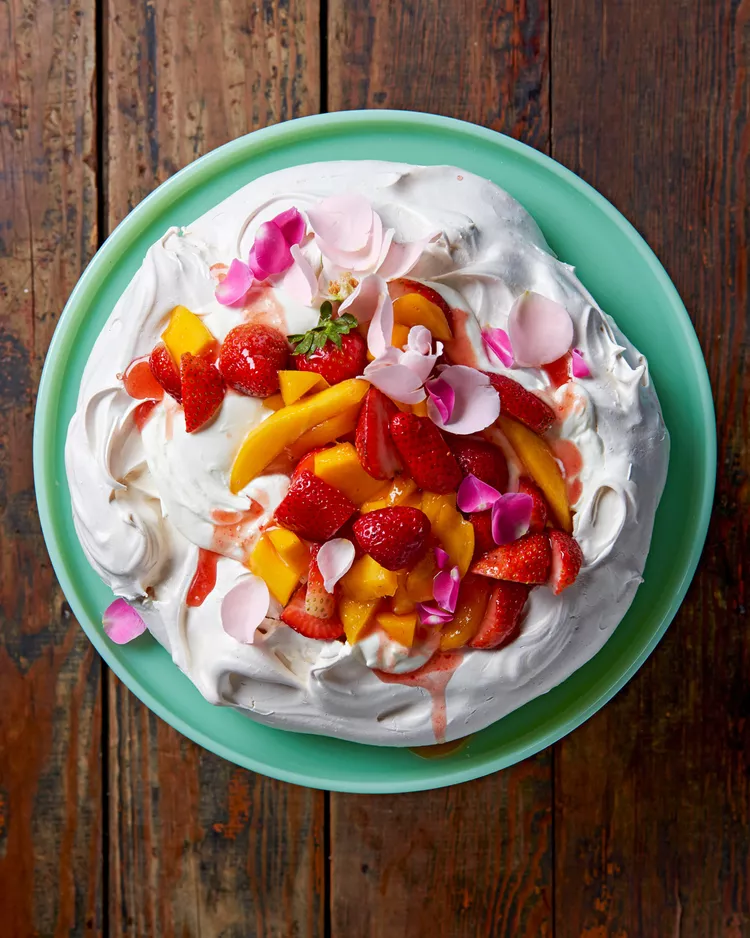What Is Pavlova, and How Do You Make It?

What is pavlova (pronounced paa-vlow-vuh)? This fluffy whipped egg white concoction is made with just a handful of ingredients. The fluffy whipped egg whites are baked into a crisp base for sweet whipped cream and fresh fruits. When learning how to make pavlova, the process takes a bit of time and patience but is really easy. Follow our step-by-step guide on making pavlova and try our tasty recipes to practice the baking technique.
How to Make Pavlova
Making pavlova will be a breeze if you've ever made a meringue-topped pie from scratch. Most pavlova recipes will have a similar meringue base. You can use our strawberry-mango and rose pavlova recipe (pictured above) as a guide, but feel free to change the fruit to whatever's in season or in your kitchen.
Step 1: Prepare Egg Whites and Pavlova Template
Separate the egg whites from the yolks and place them in a bowl. Allow them to come to room temperature for at least 30 minutes before using them to make pavlova—this allows them to whip to a higher volume. While the egg whites are hanging out, place a 9-inch baking pan on a sheet of parchment paper and trace with a dark pen or marker. Place it marked side down on a baking sheet. This serves as a guide for shaping your pavlova.
Step 2: Beat Egg Whites
In the bowl of a stand mixer with a whisk attachment, beat egg whites, cream of tartar, and salt on medium speed until soft peaks form. (A hand mixer is also perfectly fine to use here. It just might take a few more minutes to complete this step.) Turn mixer to high speed and add sugar 1 tablespoon at a time until stiff peaks form and meringue is no longer gritty (18 to 20 minutes), scraping down bowl as needed. Add in lemon juice and any additional extracts or flavorings the recipe calls for before gently folding in cornstarch.
Step 3: Bake Meringue for Pavlova
Spread meringue mixture over the circle on parchment, slightly building up edges to form a bowl-like space for the cream and fruit. Bake 1½ hours (don't open the door). Turn off oven; let dry in oven with door closed for 1 more hour. Remove; cool completely on sheet on a wire rack.
Step 4: Prepare Fruit and Cream Filling
Combine your fruit of choice with sugar and let stand 20 minutes. This technique is called macerating, allowing the fruit to soften and the natural juices to come out. In a mixing bowl, beat whipping cream (with mascarpone or other ingredients, if called for) with a hand mixer until soft peaks form.
Step 5: Build and Serve Pavlova
Spread cream mixture into the meringue shell first before spooning fruit mixture over the top. Serve and enjoy immediately.
Test Kitchen Tip
Store unfilled pavlovas in an airtight container at room temperature for up to 24 hours.
What Is Pavlova?
It's unclear who first created the famous dessert pavlova. The name (and dessert) first appeared when world-famous Russian ballerina and choreographer Anna Pavlova began touring across America, Europe, and the UK in 1910. The fruit-topped meringue once again rose in popularity after Masters golf tournament champion Phil Mickelson requested pavlova as the dessert for an annual pre-Masters meal, where he also explained the dish to his questioning colleagues.
Now that you can successfully make pavlova from scratch at home, you can get creative with the cream and fruit fillings. Utilize summer-ripe berries or garden-fresh mint for a seasonal pavlova recipe. Serve pavlova with pomegranate for a wintry take.